We earn a commission from partner links on this site. This doesn’t affect our opinions or evaluations.
Online courses have surged in popularity, enabling educators to showcase their knowledge while developing scalable business models.
Yet creating an exceptional online course is just one piece of the puzzle — mastering the art of marketing proves equally essential for success.
Many talented educators with outstanding course content struggle with promotional aspects, typically because they haven’t fully grasped the comprehensive landscape of digital marketing strategies.
Throughout my career, I’ve guided numerous course creators through marketing challenges and business expansion. Additionally, I currently serve as Partner Marketing at StationX, a leading platform specializing in cybersecurity training.
Drawing from this experience, I’ve developed this thorough guide on marketing online courses effectively. For clarity, I’ve organized the entire strategy into five key categories:
These five categories encompass 36 practical strategies in total, and we’ll explore each one thoroughly to provide you with a solid foundation for implementation.
Prior to launching any marketing initiatives, you must develop a comprehensive understanding of who specifically needs your educational content.
Gaining clarity about your target audience and crafting your ideal customer profile serves as the foundation for designing your content approach, selecting appropriate marketing channels, determining optimal pricing structures, and refining your persuasive messaging among numerous other strategic decisions.
Initially, you should thoroughly investigate the demographic characteristics, financial capabilities, personal interests, and significant challenges faced by your prospective students.
To accomplish this, consider participating in niche-specific Facebook Groups and online communities, engaging directly with potential customers, researching industry statistics, and gathering as much detailed information as possible about the people you aim to serve.
If you’ve already accumulated professional expertise in your course subject area, you’ll likely find this audience analysis process considerably more straightforward.
For those seeking a structured approach to begin this process, I recommend exploring Digital Marketer’s Customer Avatar Worksheet – a valuable resource I personally implement within my own business operations.
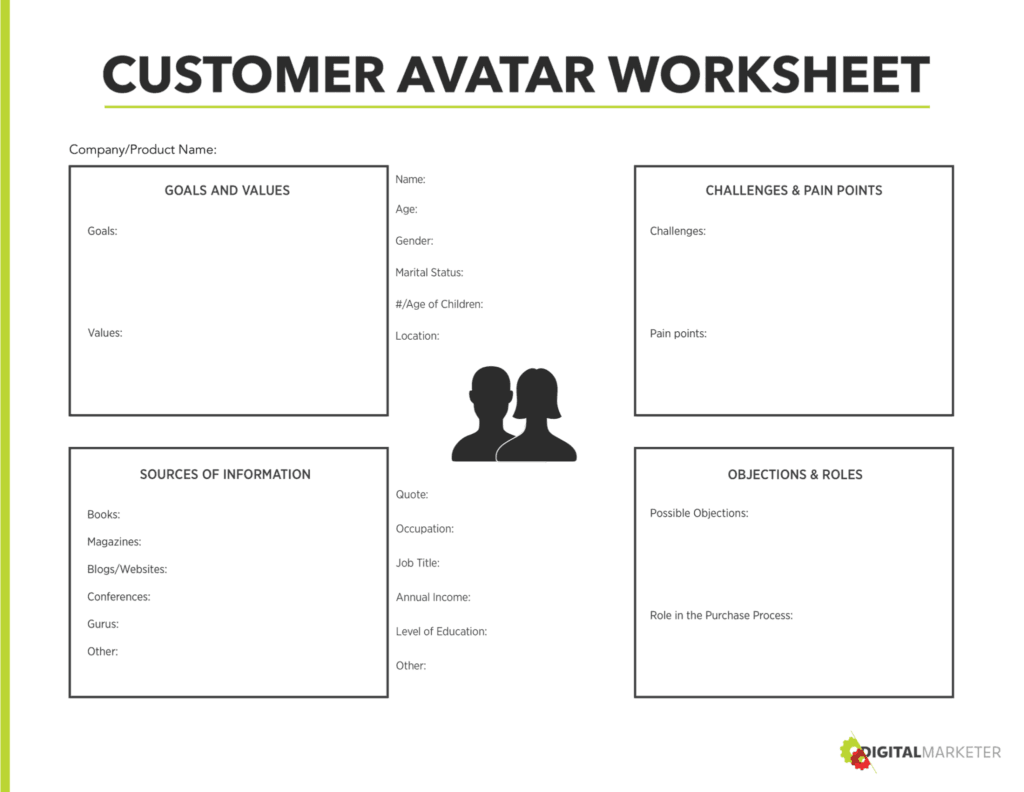
Your distinctive market offering serves as the cornerstone upon which your entire course identity is constructed. This pivotal statement should effectively communicate to prospective students what specific knowledge you provide, how your approach differs from alternatives, and the tangible benefits they’ll receive from your instruction.
Establishing a compelling value statement proves particularly crucial for independent educational businesses like yours, as it persuades potential learners to invest in your expertise rather than turning to competitors.
Additionally, this focused proposition helps refine your specialized teaching niche and craft messaging that resonates more authentically with your intended audience.
Consider this illustration: imagine you teach weight management through plant-based nutrition principles.
Your distinctive market offering might highlight that you create efficiency-focused meal solutions requiring less than 10 minutes of preparation time. This specific advantage allows you to precisely target career-focused individuals with limited available time.
After identifying your primary marketing channels, crafting a thoughtful content approach becomes essential. Your first task is to discover topics and questions that will naturally captivate your target audience.
When distributing your online course marketing across multiple platforms, you’ll need to develop a nuanced understanding of which content themes perform best on specific channels.
For instance, popular trending topics might work exceptionally well for Pinterest and Medium strategies, whereas Google requires more specialized, narrowly-focused subjects that can more easily secure favorable positions in their search rankings.
Additionally, you must strategically plan which content formats will be most effective at various stages of your customer journey.
As an example, you might want to develop informative blog content to attract new prospects, leverage Facebook live sessions to build relationships with your audience, and potentially utilize webinars as your primary course selling mechanism.
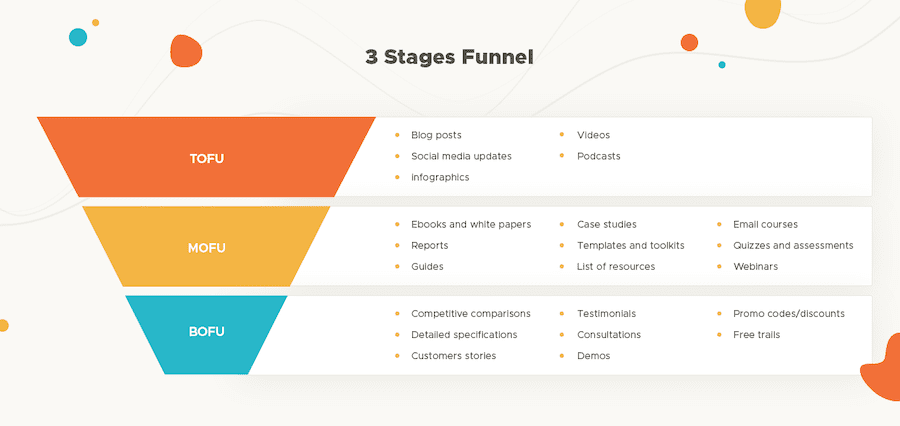
Source: Single Grain
The cornerstone of any successful marketing approach is audience acquisition – without consistently bringing new prospects into your marketing funnel, achieving meaningful results becomes virtually impossible.
Throughout this section, I’ll introduce you to several highly effective audience-building techniques specifically designed for promoting online educational products, while also providing guidance to help you determine which methods align best with your unique situation.
When you develop effective search engine strategies, Google can become an invaluable source of consistent, no-cost visitors to your digital platform.
Consider the success story of Rachael Kable, a mindfulness specialist who has successfully expanded her blog primarily through organic search visibility. She effectively leverages this blog traffic to promote her educational online offerings.
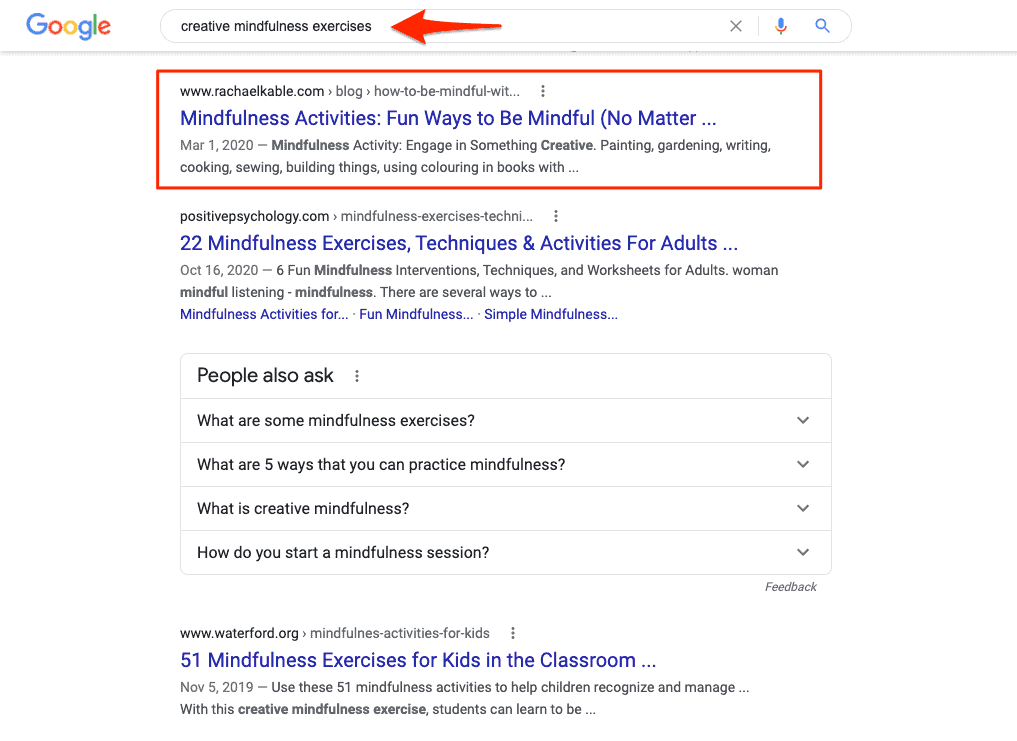
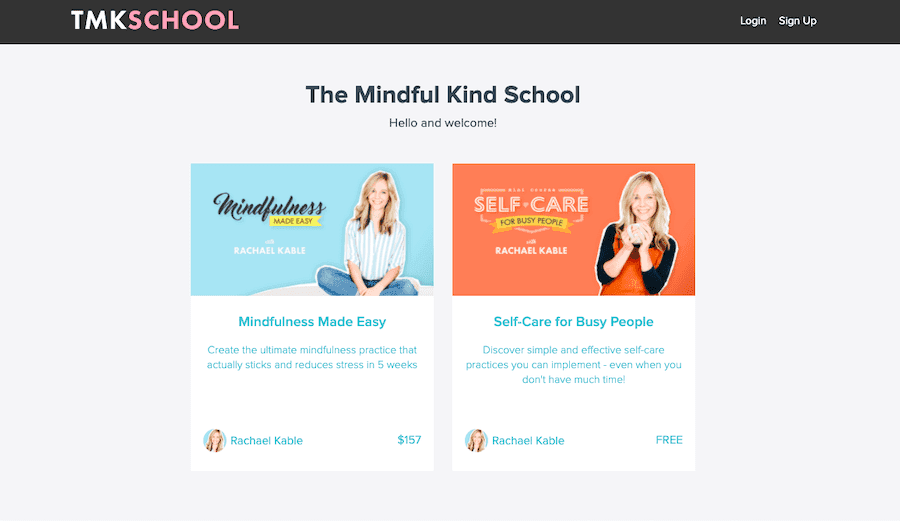
Keep in mind that achieving visibility through search engines requires patience, so you’ll need to develop and implement your optimization strategy well ahead of when you hope to see meaningful outcomes.
Initially, your focus should be on discovering relevant topics with manageable competition levels and developing exceptional content addressing these subjects. Additionally, you’ll need to actively promote your content and establish quality inbound links from reputable websites by contributing guest articles to their platforms.
You’ll find abundant search optimization guidance available online, and the premier resource I consistently recommend is Brian Dean’s Backlinko platform.
Pinterest stands as one of the most effective platforms for generating no-cost website traffic, ranking just behind Google in potential impact. The advantage of Pinterest lies in its ability to deliver quicker results, even for more competitive subject matter than what might work on search engines.
To effectively utilize Pinterest for content distribution, you’ll need to design visually striking, attention-grabbing images featuring text overlays to represent your blog content effectively.
Additionally, consider connecting with administrators of popular Group Boards to secure invitations, as participation in these collaborative spaces can significantly accelerate visibility for your content.
As a real-world success story, Alex and Lauren built a thriving digital education business in the health and wellness sector, primarily by expanding their blog, Avocadu, through strategic Pinterest engagement.
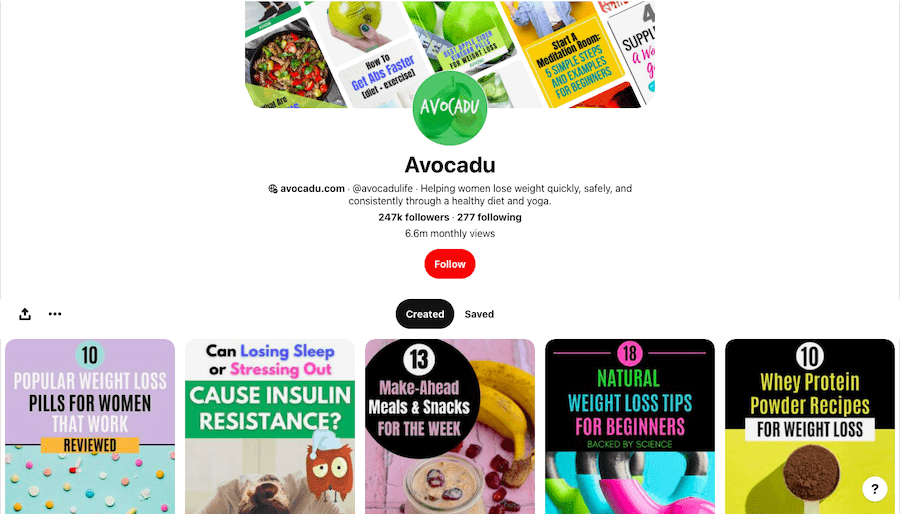
They also teach an online course about Pinterest Marketing – Pinterest Traffic Avalanche.
Creating a YouTube channel stands out as an exceptionally effective strategy for cultivating your audience and promoting your online courses.
To kickstart your YouTube presence, consider focusing on keywords with minimal competition. YouTube’s search engine optimization remains considerably less saturated than Google’s landscape, enabling you to develop a following at a relatively accelerated pace.
Furthermore, YouTube offers the opportunity to gain momentum even within highly competitive sectors (without relying on SEO) when your material delivers genuine value. The YouTube algorithm favors channels and videos that maintain extended viewer engagement and rewards comprehensive, captivating content.
Additionally, designing eye-catching thumbnail images and crafting compelling titles will entice more viewers to click on your videos. Don’t hesitate to encourage your audience to share and subscribe to your channel, as these actions significantly boost your content’s performance metrics.
Research indicates that approximately 45% of podcast listeners in the United States maintain household incomes exceeding $250,000 annually, which represents more than triple the typical American household earnings.
This demographic insight makes podcast creation an exceptionally valuable strategy for building an audience with substantial discretionary income, particularly if you’re offering premium educational products.
To maximize your podcast’s reach, distribute your episodes across multiple platforms including Apple Podcasts, Spotify, Google Play, and Soundcloud to capture diverse listener segments.
Furthermore, actively encourage your audience to subscribe, share episodes with their networks, and provide reviews. These engagement actions foster a dedicated following while simultaneously boosting your visibility within podcast discovery algorithms.
Additionally, explore strategic partnerships with fellow podcast hosts through mutual guest appearances – invite them to participate in your show while also seeking opportunities to share your expertise on their platforms.
While your capacity to generate completely original content remains finite, strategically reimagining your highest-performing materials allows you to expand your digital footprint with remarkable efficiency.
Consider how a well-crafted blog article can serve as the foundation for a compelling podcast segment, an engaging YouTube presentation, or an interactive Facebook Live broadcast.
In similar fashion, your thoughtful contributions on platforms like Quora and Reddit can be thoughtfully expanded into comprehensive blog articles or multimedia scripts.
Another effective approach involves republishing your blog content on platforms such as Medium and LinkedIn Pulse, creating additional channels for attracting potential students without additional investment.
Medium’s editorial team regularly features exceptional content, significantly amplifying its reach—making content quality your primary focus for gaining visibility within this ecosystem.
Regarding LinkedIn Pulse, this platform remains surprisingly underutilized and can deliver exceptional results particularly for those operating within business-related educational niches.
Active involvement in Reddit and Quora discussions represents a well-established strategy for attracting quality traffic with comparatively minimal effort investment.
For Reddit engagement, identify subject-specific subreddits aligned with your course material and begin meaningful interactions within these communities. Share valuable resources or provide thoughtful responses to community inquiries, naturally incorporating relevant links to your website while maintaining an authentically helpful rather than promotional approach.
When utilizing Quora, search for questions directly related to your course subject matter and craft comprehensive, insightful responses that demonstrate your expertise. Seamlessly integrate links to your website where they provide additional context or value. When your contributions genuinely solve problems or provide exceptional insight, they naturally attract more upvotes and visibility, ultimately driving increased traffic to your educational offerings.
Drive traffic to your educational website by offering a condensed course on Udemy. Udemy stands as the premier online education marketplace with an expansive community of over 70 million learners available for you to connect with.
The platform permits instructors to distribute educational notifications to enrolled students, allowing you to incorporate links to your website within these communications. This feature enables you to showcase your blog articles and complementary resources, effectively guiding potential customers into your comprehensive course ecosystem.
Furthermore, since revenue generation through Udemy isn’t your primary objective, consider developing a complimentary introductory course on the platform. This approach will attract a larger student base on Udemy, subsequently increasing visitor flow to your main educational website.
Deploying strategic paid advertisements offers one of the most efficient methods to attract highly-targeted visitors to your marketing sequences. Among the various advertising platforms, Google, Facebook, and YouTube emerge as the most widely utilized options.
Google Ads enables you to position search advertisements prominently at the top of search results pages or feature display advertisements across various blogs and websites through their extensive advertising network.
With search advertisements, you gain the ability to precisely target individuals actively searching for specific keywords within your specialty area. This targeted approach allows you to direct traffic either to informative blog content or directly to your course sales pages.
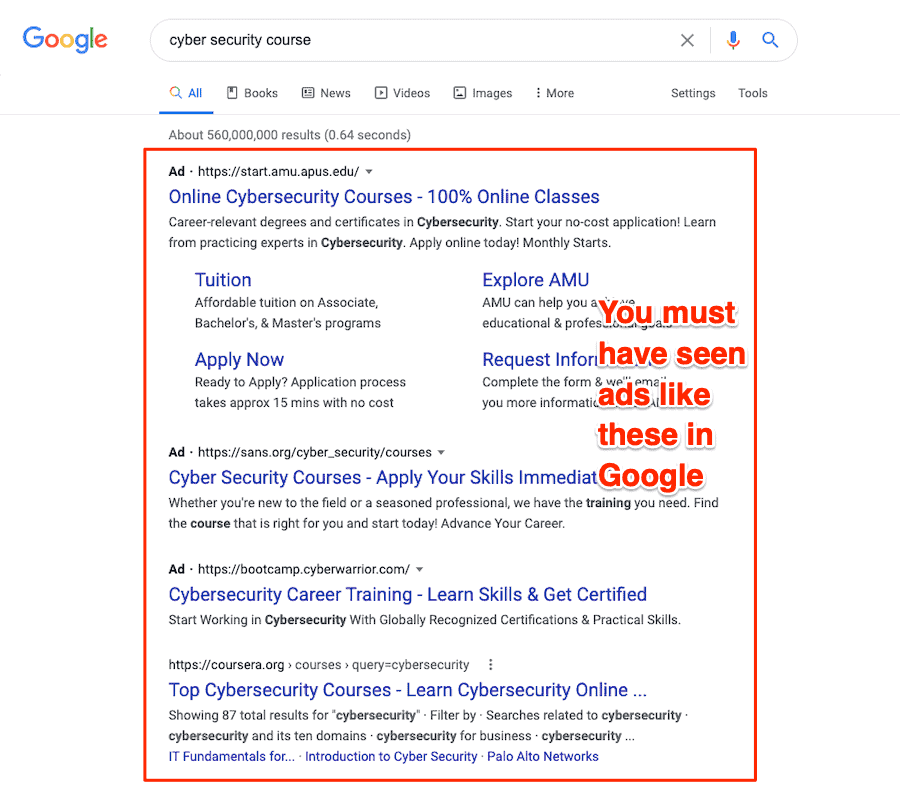
Facebook advertising allows you to connect with users through various parameters such as geographic location, personal interests, age demographics, career fields, and even previous shopping habits. Your campaign options include static images, multi-image carousels, and engaging video content.
When utilizing YouTube, you can display advertisements based on specific search terms, plus target particular YouTube channels or individual videos. You also have the ability to reach YouTube viewers based on their Google search patterns.
Beyond these major platforms, numerous other advertising channels exist including Instagram, Pinterest, and Reddit communities. Depending on your specific industry and business objectives, one of these alternatives might better align with your marketing strategy.
To expand your email subscriber base and encourage website visitors to provide their contact information, you’ll need to offer something valuable in return. Free resources serve as one of the most effective methods to accomplish this goal.
Additionally, delivering a premium-quality free resource helps establish credibility and foster initial confidence with your potential audience.
Numerous resource options exist for you to explore. Popular formats include comprehensive checklists or informative digital guidebooks.
For instance, at StationX, we provide a complimentary cybersecurity career roadmap as our incentive, which delivers exceptional conversion results.
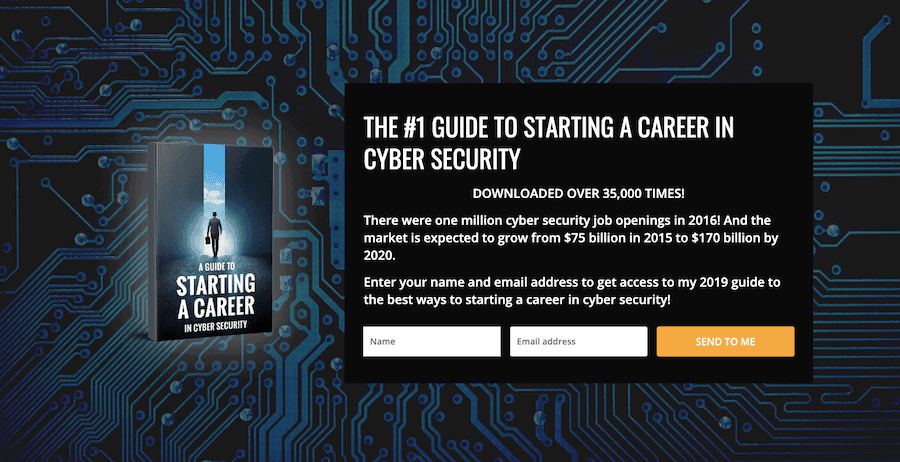
Alternatively, you can structure your complimentary content as a condensed learning module or sequential email lessons to craft an even more compelling free resource.
As an illustration, Tom Kuegler, who instructs writers on audience development and income generation through Medium, provides a complimentary 5-day email training series on his website.
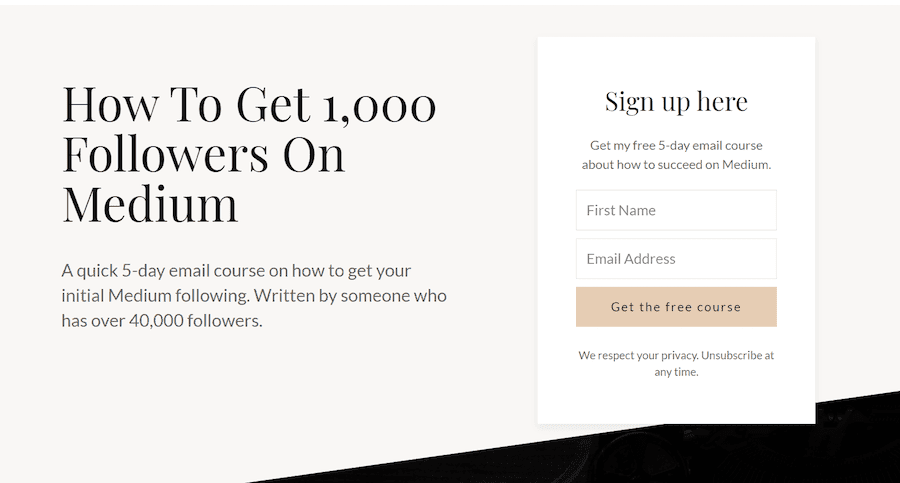
Additionally, these specialized enhancements typically require minimal creation effort. For example, with comprehensive articles, you might provide a downloadable PDF version that readers can save for later reference. Alternatively, you could transcribe your podcast episodes and offer the written version as a valuable extension.
Below is an illustration of “a PDF with accompanying templates” functioning as a content extension from Wishpond:
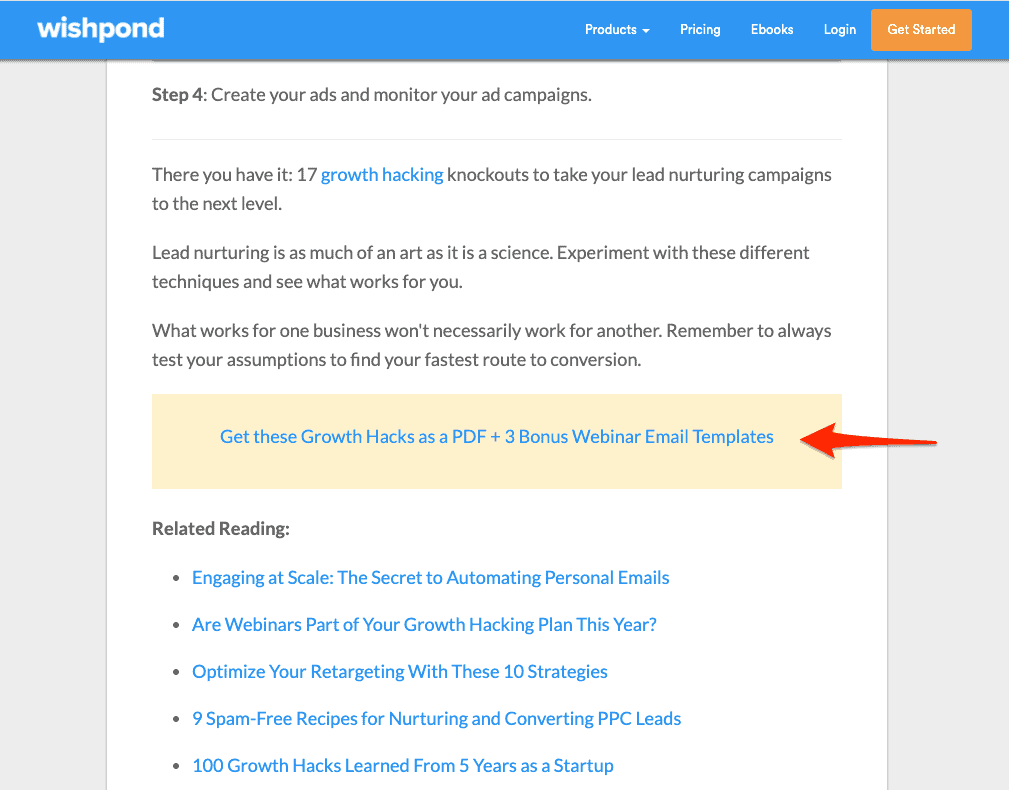
Assessment tools and interactive experiences serve as exceptionally powerful methods for both generating and qualifying potential leads.
To develop marketing assessments, you can utilize specialized assessment creation platforms like Interact or implement versatile form solutions such as Paperform. The essential strategy involves posing relevant questions and delivering customized feedback based on participant responses.
For illustration, Nadalie Barod implements an assessment titled “What Should Your Goal Be?” on her website to attract prospective subscribers:
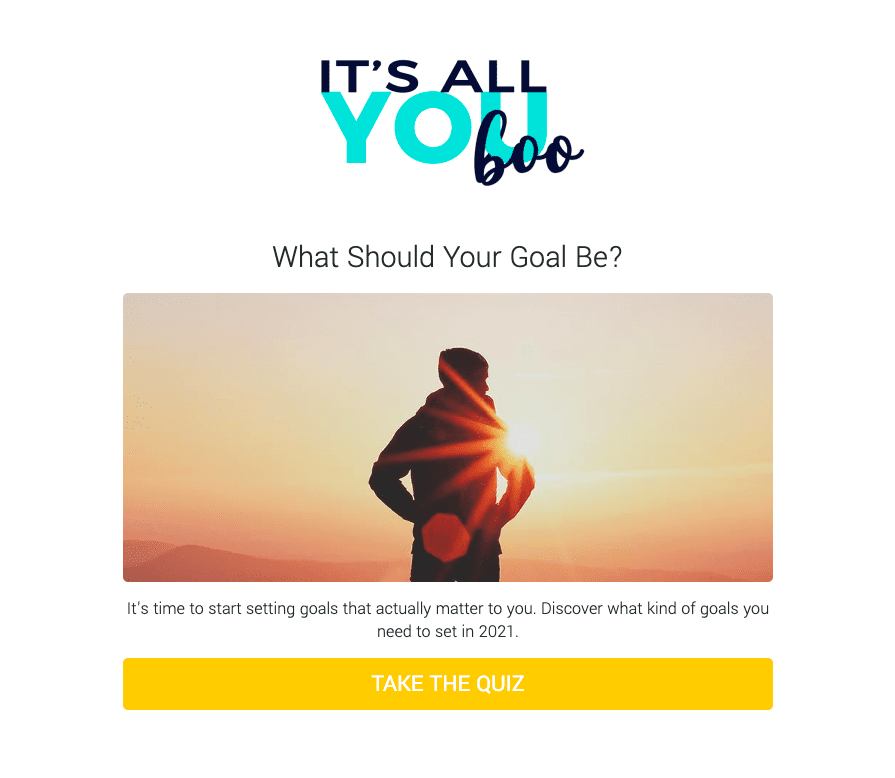
To effectively grow your email subscriber base, you need more than just valuable free resources or enhanced content – you must also capture visitor attention and convince them to join your list through strategically designed subscription forms.
Currently, numerous subscription form variations exist, and you should experiment with different styles to determine which performs optimally for your specific audience.
You might implement an immersive full-screen subscription experience, position a form within your sidebar, place a notification strip at the page top, or introduce a sliding element that appears from the margin. Alternatively, you could deploy a centered overlay that displays prominently or integrate a permanent subscription opportunity at the page conclusion.
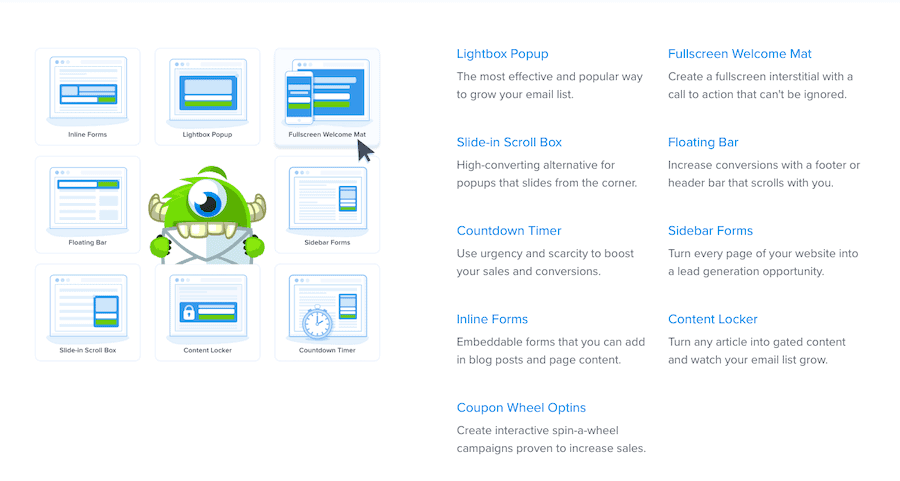
Feel free to implement various opt-in form styles throughout your website without creating an overwhelming experience for your visitors.
To develop these customized opt-in forms, you’ll need a dedicated solution such as ConvertBox. Alternatively, you might utilize the ready-made opt-in forms available through your email marketing platform.
Beyond experimenting with different opt-in form varieties, you should employ proven strategies to enhance your email subscription rates.
To begin with, craft a compelling call to action and visually engaging forms by utilizing the pre-designed templates available through your opt-in form provider.
Equally crucial is displaying your opt-in forms at strategic moments. Consider implementing time-triggered popups that display after visitors have engaged with a page for a specific duration, or deploy exit-intent popups that activate when users demonstrate leaving behavior.
Additionally, you might develop progressive multi-step forms featuring Yes/No options in the initial stage to minimize resistance for potential subscribers.
Here’s a demonstration of a multi-stage popup created with OptinMonster:
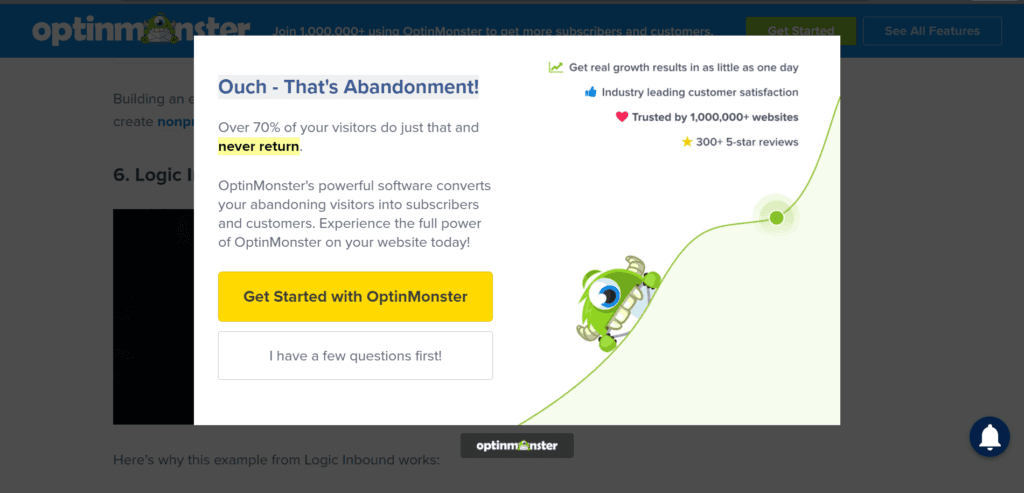
Creating tailored landing pages for different visitors represents one of the most effective conversion optimization techniques available.
You have the ability to display customized headlines, text, and even visual elements to various visitor segments. You can further enhance personalization by presenting different lead magnets to different audience groups.
Your personalization approach might be based on visitor origin, such as specific referring domains or Facebook Ad campaigns. Alternatively, you could implement customization based on their Google search terms or their existing relationship with your email database.
A specialized solution like RightMessage provides the capabilities to implement all these personalization strategies effectively.
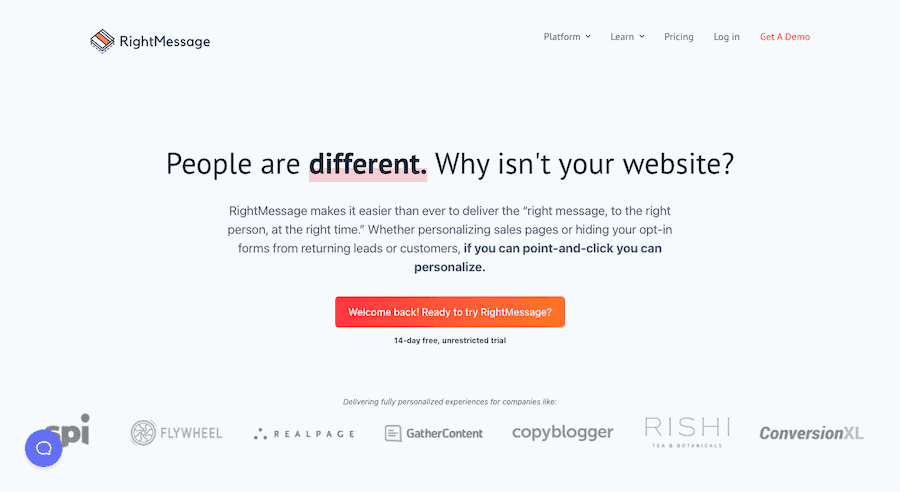
After establishing your initial subscriber base, you can implement an advocacy program that motivates your audience to recommend your email newsletter to their connections.
To enhance participation rates, consider offering compelling incentives such as complimentary mini-courses, valuable digital guides, or special discounts on your premium educational offerings.
To streamline this process, consider utilizing a specialized platform like SparkLoop, a dedicated newsletter referral system that seamlessly connects with most mainstream email marketing platforms available today.
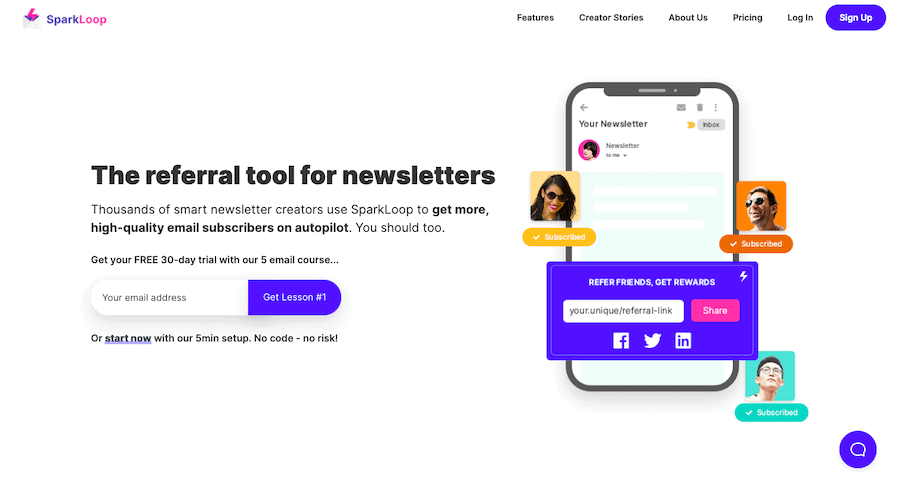
Research from a notable industry analysis indicates that introductory emails achieve engagement rates 86% higher than standard email communications. Therefore, delivering a carefully crafted series of onboarding messages immediately following subscription can dramatically influence whether you establish a meaningful connection with subscribers or lose their attention entirely.
Furthermore, when you consistently deliver valuable insights through your welcome sequence, subscribers naturally develop familiarity, appreciation, and confidence in your expertise—establishing the essential foundation that simplifies your eventual sales conversations.
For instance, at StationX, our approach involves sending new community members a sequence of educational emails addressing common misconceptions within the cybersecurity landscape, which has proven exceptionally effective for our business objectives.

As you might expect, maintaining regular communication with your audience plays a vital role in fostering engagement with your brand. Your recurring emails should include informative content that provides genuine benefits rather than solely promotional messages selling your course.
If you maintain a blog, YouTube channel, or podcast, consider distributing your fresh content to your audience through email. Additionally, you can incorporate links to upcoming webinars and Facebook Live events within your messages.
To enhance reader engagement, consider personalizing your email content, weaving narrative elements throughout, incorporating interactive features such as quizzes & surveys, and encouraging recipients to respond directly to your communications.
Dividing your email subscribers into distinct categories for delivering customized content represents an excellent strategy to enhance audience engagement.
For example, you could invite new subscribers to select their specific interests or pain points during your initial email sequence and subsequently deliver tailored information based on these preferences.
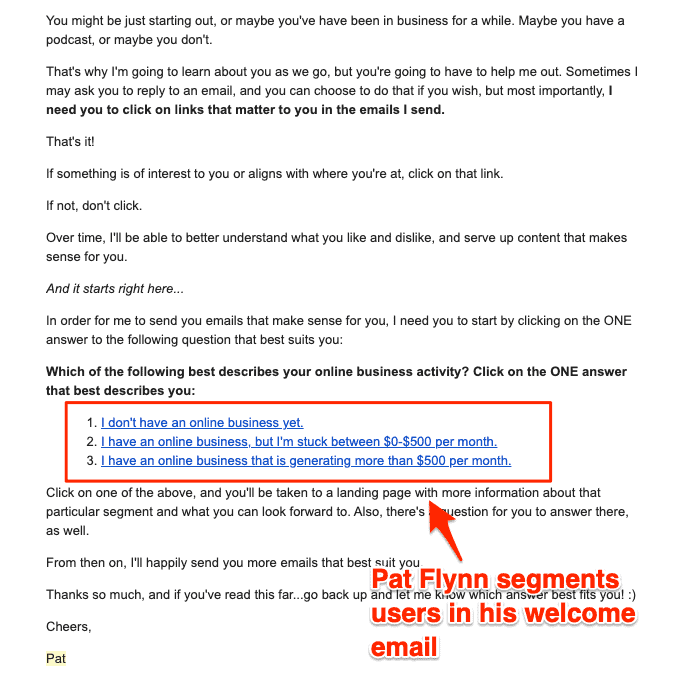
Furthermore, you can classify subscribers based on their entry point to your list, whether they engaged with a link, participated in your webinar, or previously purchased your course.
The core principle behind segmentation involves delivering appropriate messages to suitable recipients, which will enhance your email engagement metrics and minimize subscription cancellations.
Monitoring key indicators such as email open and click-through rates through email marketing software proves essential for maintaining message deliverability and maximizing the return on investment for your marketing initiatives.
For example, failure to periodically refine your email list by removing consistently unengaged subscribers can result in a significant portion of your communications being directed to spam folders. This situation can dramatically affect your overall email deliverability performance.
Furthermore, you can utilize statistics like open and click-through rates to experiment with different subject lines and message content to enhance subscriber engagement.
In addition to nurturing your audience through email communications, consider developing an online community to elevate audience engagement to new heights.
Generally speaking, you can approach this through two distinct methods.
You might implement a dedicated community platform such as Mighty Networks, which enables you to construct a community within your own website environment.
Alternatively, you could utilize Facebook Groups, where your target audience likely already maintains a presence, potentially making it somewhat easier to generate meaningful interactions.
Retargeting empowers you to display advertisements to subscribers who haven’t recently interacted with your email communications. By consistently connecting with users through strategically placed ads, you build powerful brand recognition that naturally enhances your conversion rates.
Furthermore, when someone from your subscriber database revisits your website, you can intelligently present them with a direct purchase call-to-action instead of another signup prompt.
Additionally, retargeting allows you to showcase advertisements to visitors who previously explored your website but haven’t yet joined your email community.
You can even customize different ad experiences based on specific user behaviors or the duration of their website engagement.
Establishing a distinctive professional identity that showcases your expertise will be essential for driving your course sales.
To cultivate your personal brand, craft an engaging narrative that highlights your professional achievements or real-life experiences. You’ll also need to incorporate high-quality photographs and professionally designed visuals that authentically reflect your personality.
Your brand presence can be established across multiple platforms including your website, social media profiles, YouTube channel, and more.
Take inspiration from how Rachael Kable masterfully combines an authentic story with polished photography and attractive visuals to establish her professional identity.

Before crafting promotional text for your website, email campaigns, or virtual presentations, you must establish your fundamental marketing message. In essence, you should articulate in just a few sentences why prospective students would benefit from purchasing your course.
Your marketing message needs to communicate elements such as the specific challenge you resolve for your audience and what distinguishes your offering as both unique and beneficial.
When perfecting your promotional content, remember that elaborate writing style or exceptional eloquence isn’t necessary. What truly matters is communicating your course’s benefits as clearly and efficiently as possible.
Consider this excellent example of straightforward promotional content on Jasmine Shea’s meal-preparation course website, where she clearly communicates exactly what participants can expect to gain from her program.
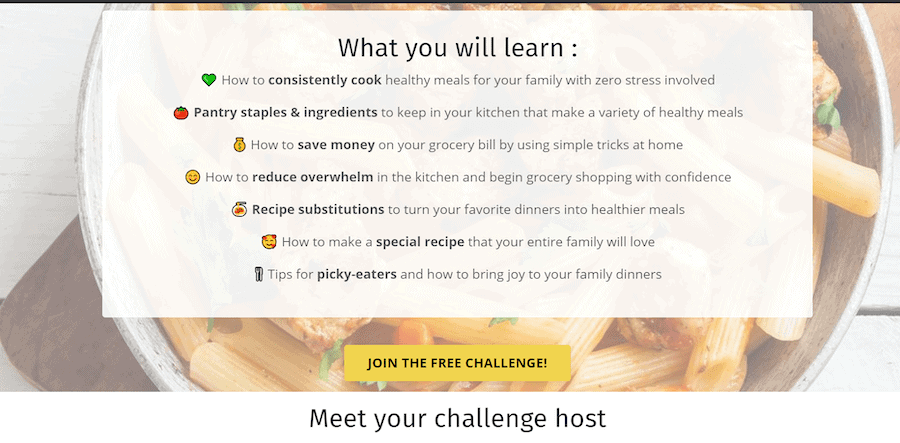
Potential students naturally want evidence that others have benefited from your educational offering before making a purchase. Therefore, customer validation will serve as one of the most crucial elements driving your course’s market success.
To effectively demonstrate customer validation, feature student endorsements across your website, YouTube presence, email communications, and other channels. For even more compelling evidence, invite select graduates to record brief video testimonials using their mobile devices.
Examine this excellent implementation of customer validation through testimonials from Avocadu’s Yoga Fat Loss Bible program.
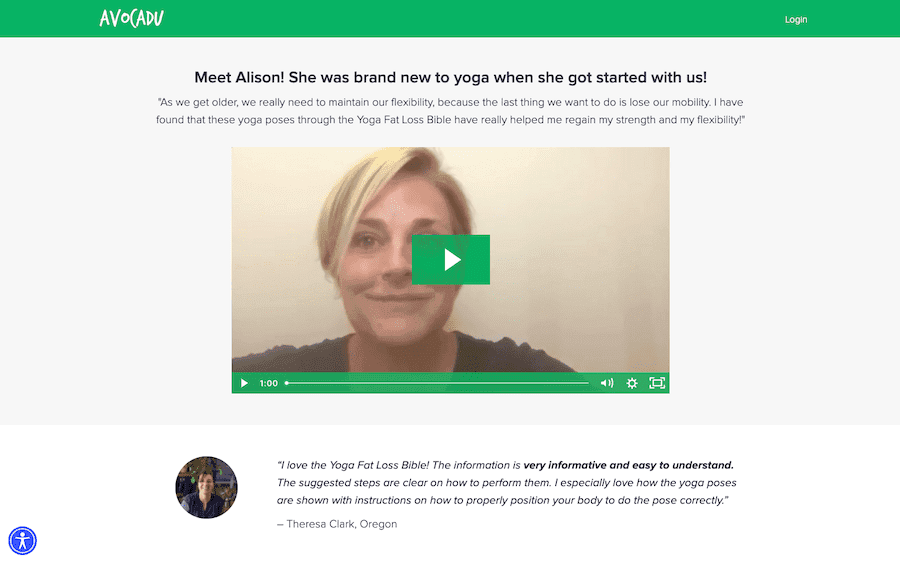
It’s highly unlikely you’ll optimize your email subject lines, message content, destination pages, social media advertisements, or any component of your marketing sequence on your initial attempt.
Therefore, implementing comparative tests across various stages of your marketing sequence represents one of the most straightforward approaches to enhance conversions, and any quality marketing sequence platform will provide this capability.
Additionally, when executing comparative tests, apply the Pareto principle and focus on experiments most likely to generate significant improvements with minimal investment.
For perspective, Graham Cochrane, who manages an educational program in audio production, discovered that simply presenting his promotional webinar invitation in the initial email rather than the third communication increased his revenue by 89%.
Hosting a dynamic sales webinar or developing an engaging video series to share with your email subscribers represents one of the most effective strategies for finalizing online course sales, with the vast majority of successful course creators implementing one of these two powerful approaches.
During your sales webinar, focus on delivering substantial value and establishing genuine trust before transitioning to your course offering. You have the flexibility to conduct an interactive live webinar, while also recording the session to make it accessible to your audience members who couldn’t attend the original broadcast.

Amy Porterfield uses webinar to sell her courses
I discovered the crucial significance of crafting a persuasive offer when I participated in the comprehensive online program by James Wedmore titled Business By Design where he thoroughly explores this essential concept.
Incorporating valuable bonus materials alongside your primary content can significantly enhance the attractiveness of your courses and boost your conversion rates.
When designing bonuses, consider developing supplementary content related to your main course subject, and include practical resources such as customizable templates, structured action plans, interactive worksheets, and similar tools. Additionally, you might offer exclusive group coaching sessions and provide access to a dedicated private community or specialized Facebook Group.
Furthermore, if you’ve developed multiple courses, consider strategic bundling by packaging them together, perhaps offering a more compact course as a complimentary bonus with your more comprehensive flagship course.
Incorporating urgency elements stands as one of the most powerful persuasion techniques for elevating the perceived value of any digital offering.
Various effective approaches exist for implementing strategic urgency when marketing your online educational content.
Initially, you might provide access to your course during a specific enrollment period, deliberately closing registration afterward. Additionally, you can incentivize early action by offering exclusive discounts to participants who enroll promptly.
Furthermore, by utilizing specialized software like Deadline Funnel, you can establish individualized deadlines (featuring dynamic countdown timers) tailored for each potential student, enabling you to maintain motivational urgency even when your course remains available throughout the calendar year.
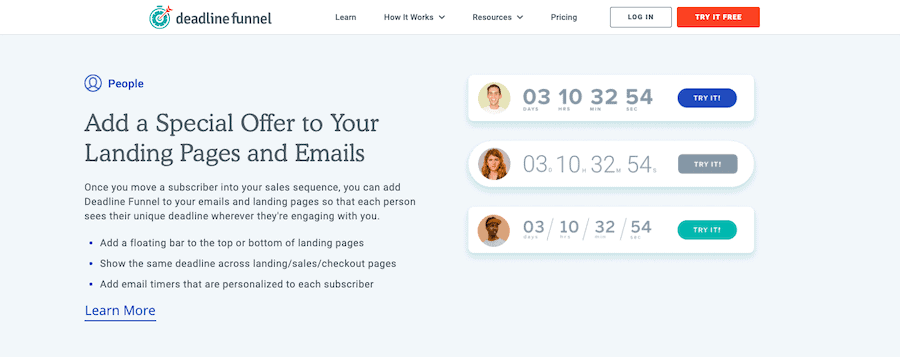
Certain prospective students may experience hesitation when considering purchasing your educational program, particularly if they lack extended familiarity with your brand identity.
To effectively alleviate these concerns, implement a comprehensive satisfaction guarantee and commit to providing complete refunds for any participants who express dissatisfaction with your educational materials. This practice represents a widely accepted standard within the digital education industry, where shipping expenses are nonexistent and refund frequencies typically remain exceptionally low.
As a general professional recommendation, course creators should consider offering an unconditional 30-day satisfaction guarantee; however, when marketing premium-priced programs, you might reasonably adjust this timeframe to a more concentrated 14-day evaluation period.
An additional straightforward strategy to enhance your conversion metrics involves implementing installment payment options for your educational offerings. This approach becomes particularly essential when marketing premium-priced courses, as numerous potential students may experience reluctance when considering substantial one-time investments.
Furthermore, consider structuring your pricing to include both installment options alongside traditional single-payment alternatives, potentially incorporating a modest price differential to account for the extended payment timeline.
Conveniently, virtually all leading digital education delivery platforms and e-commerce solutions currently available provide robust functionality for establishing customized payment schedules for your prospective students.
Research has revealed that approximately 70% of online shopping carts are left unfinished across various industries, according to a comprehensive market analysis. This presents a valuable opportunity—reaching out to visitors who browsed your checkout page but didn’t complete their transaction can dramatically enhance your conversion rates.
Within these recovery messages, consider including a limited-time discount or exclusive bonus material to entice prospects back. Creating a sense of urgency in your offer can effectively motivate swift decision-making from hesitant customers.
Additionally, refining your messaging to specifically address potential customer hesitations can make all the difference. With thoughtfully crafted follow-up communications, you’ll successfully guide many previously undecided prospects toward finalizing their purchase of your educational content.
A highly effective strategy for expanding your online course reach involves establishing a partner referral network that motivates fellow content creators and industry influencers to showcase your educational materials.
For example, you might collaborate with established bloggers and YouTube channel hosts to provide honest reviews of your curriculum, thereby tapping into their established audience base and the credibility they’ve cultivated with their followers.
Another powerful approach involves forming strategic alliances with other educators who maintain substantial email subscriber lists, encouraging them to promote your courses in exchange for a percentage of the resulting revenue.
The tremendous advantage of referral marketing and strategic partnerships lies in their cost-effectiveness—you invest nothing upfront since compensation occurs only after successful sales transactions.
Virtually every leading course developer implements some variation of a referral program for their educational offerings, making this my preferred promotional technique in the industry.
As you’ve discovered, successful online course marketing encompasses a diverse array of carefully planned activities. I’ve worked to streamline this comprehensive promotional framework into digestible components for your implementation.
Initially, you’ll need to select your traffic generation channels and content approach based on crucial elements such as your specific audience demographics, personal capabilities, and available financial resources.
Subsequently, you must implement effective strategies to convert website visitors into email subscribers. Additionally, maintaining consistent audience engagement through regular valuable content distribution and analyzing your email campaign performance metrics becomes essential.
Ultimately, you’ll need to incorporate proven conversion techniques including developing compelling sales messaging, creating irresistible bonus offerings, and strategically incorporating testimonials to effectively sell your educational materials.
I trust you found this guide valuable and that it has equipped you with practical knowledge on effectively promoting your online courses.
Should you have any questions or wish to contribute additional marketing insights I may have overlooked, please share your thoughts in the comment section below.

Daniel NicFounder, SellingOnliceCoursesGuide.comis an entrepreneur and digital education specialist who founded sellingonlinecoursesguide.com, a platform dedicated to helping creators and educators successfully navigate the online course marketplace. Through his website, he shares insights and strategies for developing, marketing, and monetizing online educational content. His work focuses on empowering course creators to build sustainable online businesses while effectively sharing their knowledge with students worldwide.

Daniel Nic is an entrepreneur and digital education specialist who founded sellingonlinecoursesguide.com, a platform dedicated to helping creators and educators successfully navigate the online course marketplace. Through his website, he shares insights and strategies for developing, marketing, and monetizing online educational content. His work focuses on empowering course creators to build sustainable online businesses while effectively sharing their knowledge with students worldwide.

We respect your privacy and will never spam you.